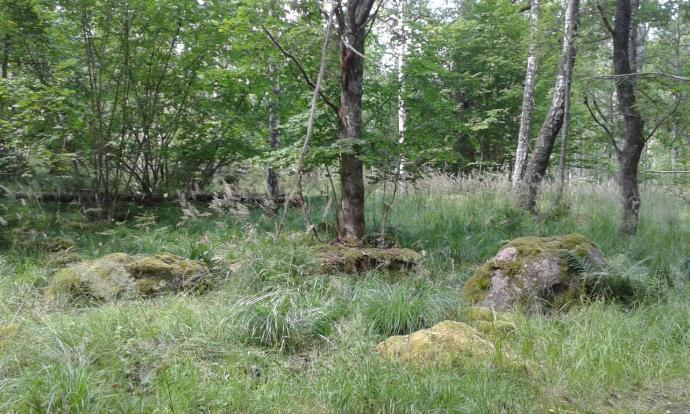Abstract
As a result of changes in grass sward composition and vegetation structure, as well as overgrowth of trees and bushes in woodlands, many woodland butterfly species have declined across Europe. Lopinga achine is a flagship species of woodlands and it has gone extinct from several habitats in Europe. The aim of this study was to determine the effect of habitat factors on the occurrence of L. achine and investigate if alteration in such habitat factors effect on their movement pattern. The occurrence of the butterflies and sampling habitat factors was recorded in transect method in 11 sites in the province of Östergötland, south east of Sweden. Furthermore, movement pattern and flight speed of 25 individuals were tested in two sites with different habitat structure. Habitat variables including host plant (Carex montana) abundance, grass sward height, tree and bush canopy cover and also fern abundance, had a significant effects on the occurrence of the species. In addition, open area with short grass height and less canopy cover affected the movement pattern and speed of L. achine and individuals flew more straight and faster in open areas. In conclusion, results shown that habitat factors are important for the occurrence of L. achine and population viability. In addition, alteration in habitat structure such as short grass sward height and lack of bush and canopy trees effect on butterflies’ movement behaviour, which may lead to population decline or extinction of Woodland Brown from its habitats.
A short glance at the study species
Why we should concern about butterflies?
The aesthetic value of butterflies is known by everyone, and so it gives us lots of economical benefits especially in ecotourism. Butterflies are sensitive to habitat changes and known as a good indicator of habitat destruction and degradation. They are a good source of food for other species of animals particularly bats and birds and play a major role in food chain. In addition they are main host of parasitoids and control their population. These examples show why the study of butterflies is important especially for conservation programs. Unfortunately, butterflies were unlucky such as other animal species and not all of them survived after the humans' footprint appeared in their habitats. Alterations in ecosystems as a result of fragmentation and habitat destruction made their habitat an unsuitable place to live and so, sever population decline and extniction occurred in many species. Meanwhile, lots of these population decline and extinction happened in Europe. Nowadays, more studies and conservation programs concern about preserving butterflies' populations all around the world. And that was the aim of my study indeed.
What is woodland Brown?
Woodland Brown with the scientific name of Lopinga achine is the woodland butterfly species and belongs to the family of Nymphalidae. It is a palearctic butterfly with a wide global distribution from Asia to Europe. The species is inhabits in mixed woodland areas, decidiouos and coniferous forests. L. achine is sensitive to the successional stage of habitat and has specific habitat requirements, particularly during opviposition and larval stage. Therefore, it prefers narrow zones under tree canopy and bushes, specially along the edges of glades with the presence of the host plant. During the last decades, more than 30% population decline, has been reported for this species in Europe. As a consequence, L. achine is classified as Vulnerable in the IUCN redlist 2015, and placed as Near Threatened in the Swedish Red Data Book 2015 . In Sweden the populations are distributed in two regions, in the island of Gotland and the province of Östergötland in south-east of Sweden which was covered my study area.


Responsible for this page:
Director of undergraduate studies Biology
Last updated:
